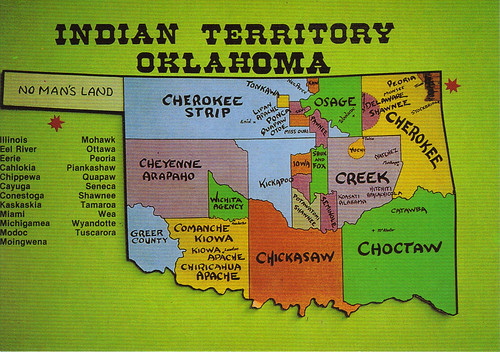5th Posting: Tribal Dissolution: Oklahoma & Catholic Outposts: The Ojibwa and Sioux
As Native tribes began to disband in the late 1800s John Benedict, a Muskogee leader, was appointed as the first U.S. superintendent of schools in Indian Territory. His leadership was not as well received as one would have assumed. He pointed out the short comings of the boarding, day and neighborhood schools, including the education offered in orphanages. He highlighted the defects in supervision, financial management, poor attendance, and the lack of English in the curriculum. He pointed blame to the tribal leaders stating that the schools hired unqualified teachers. After five years and guided reinforcements Benedict reported that improvements had been made. A general understanding and trust surfaced between Benedict and the tribal leaders as schools for teachers were developed (Normal Schools) and school attendance increased.
Although education improved and teacher requirements increased not all schools had the financial viability to stay open. Orphanages in Indian Territory became stricter in taking in orphans and become diverse within them. There were four types of orphanages in existence – African-Indian and black home (Taft), state orphan home (Whitaker), denominational (Murrow, Goodland) and federally supported (Sequoyah, Wheelock).
The first recorded Native American child to enter a denomination orphanage was Navajo child named Mary Carleton. The child was given her christened name by the Sisters of Mercy in Sante Fe with her last name given for General Carleton who found the infant on a battlefield in New Mexico in 1865. The focus of this orphanage was not to take in Native orphans but that of Anglo and Mexican heritage. Catholic orphanages in the Northern Plains focused upon tribal orphans particularly in the Dakotas and Minnesota.
Unlike the Five Civilized Tribes’ state run orphanages who received federal and state monies, the initial denominational orphanages of the Plains were supported through whatever meager donations could be scoured up through charity. Many missionaries learned the languages of the Plains Indians in order to preach and teach. The patience practice of language learning built trust between the people and the missionaries and small numbers began to convert to the religion brought by the missionaries. Once converted, they were expected to convert others. The orphanages’ curriculum stressed religious practices, English, and vocational training (agricultural - males, domestic operations- females).
Although education improved and teacher requirements increased not all schools had the financial viability to stay open. Orphanages in Indian Territory became stricter in taking in orphans and become diverse within them. There were four types of orphanages in existence – African-Indian and black home (Taft), state orphan home (Whitaker), denominational (Murrow, Goodland) and federally supported (Sequoyah, Wheelock).
The first recorded Native American child to enter a denomination orphanage was Navajo child named Mary Carleton. The child was given her christened name by the Sisters of Mercy in Sante Fe with her last name given for General Carleton who found the infant on a battlefield in New Mexico in 1865. The focus of this orphanage was not to take in Native orphans but that of Anglo and Mexican heritage. Catholic orphanages in the Northern Plains focused upon tribal orphans particularly in the Dakotas and Minnesota.
Unlike the Five Civilized Tribes’ state run orphanages who received federal and state monies, the initial denominational orphanages of the Plains were supported through whatever meager donations could be scoured up through charity. Many missionaries learned the languages of the Plains Indians in order to preach and teach. The patience practice of language learning built trust between the people and the missionaries and small numbers began to convert to the religion brought by the missionaries. Once converted, they were expected to convert others. The orphanages’ curriculum stressed religious practices, English, and vocational training (agricultural - males, domestic operations- females).
http://www.franciscans-stella-niagara.org/SD%20Indian%20Mission.jpg



No comments:
Post a Comment